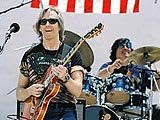My Writing Process, Part 4
Hooks Don't Have to Be Just Melodies
One of the lessons I've learned about arrangements is that hooks can -- and should -- occur anywhere in a song. Sure, the most important one is the chorus melody (and lyric) that listeners can remember. But a cool guitar riff, a simple synth line; even a drum groove or percussion fill can be a hook.
Once the song is "written," the challenge during the process of arranging is to create and refine those hooks throughout the song. As players, you often have to "step back" from the music, and hear it like a non-musician listener would. A simple break that seems elementary to you may be just the thing that gets an audience pumped.
Other Songwriting TechniquesIn the vein of song writing techniques, I have another that may not be that common: I don't record any part of a song until we're actually working on the full arrangement with the band. Seem crazy? It works for me, and here's why:
Once a song, or even just an idea, gets recorded, it makes it more difficult for me to adapt it. As a writer, I'm constantly editing and refining what I do, so that as I'm creating a song, it's gradually evolving. In fact, one important part of this process is mistakes. In playing something, if I make a mistake that happens to sound cool, I incorporate it!
The other reason is that I find it difficult to focus my energy on the writing process at the same time as the recording process. If I try to do them simultaneously, one or both of them suffers.
 Fitting Rock Guitar Into Latin Music
Fitting Rock Guitar Into Latin MusicSince my inspiration is not Santana but rather more traditional Latin music, having the guitar serve as a prime instrument is an obstacle. In these genres, the roles are very defined:
- Piano plays the "montuno," or repetitive syncopated chord arpeggiations. This carries the harmony.
- Bass plays a sparse, angular pattern that avoids the "one" beat like the plague. This helps to set the rhythmic tone.
- Horns play the lead lines, and add chordal stabs, swells, and other effects. Thus creating -- other than the vocals -- the key melodic components.
- Guitar, when it is used, generally plays a supporting chordal rhythm pattern, and is pretty much in the background.
So, how does someone who grew up playing rock "lead" guitar fit it into a Latin format? Fat, overdriven guitar can work for playing melodies, but not in the way that a trumpet or a horn section can. To make the guitar work in a lead role, I utilize several techniques:
1) When we need horn "stabs," the keyboards cover them, and I play a montuno-like pattern on the guitar.
2) In order to achieve simple, trumpet-like melodic lines, I have the vocalist or a synthesizer double the line with me, in addition to utilizing doubled guitar technique (one bent note matching a straight note).
3) I employ playing techniques to enhance simple lines, such as bends, slides up or down, and unique, syncopated rhythmic phrasing.








